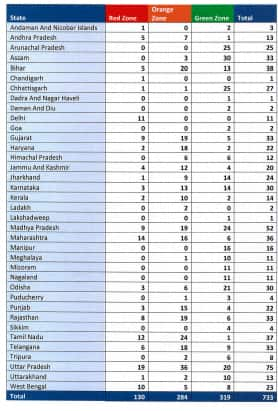Bengaluru, Chennai fall in coronavirus COVID-19 red zone, check list of red zones in Karnataka and Tamil Nadu
The Union Health Ministry on Friday split 733 districts across India into red, orange and green zones, pulling out all metropolitan cities - Delhi, Mumbai, Chennai, Kolkata, Hyderabad, Bengaluru and Ahmedabad into the 'no activity' or red zone.
Trending Photos
)
NEW DELHI: The Union Health Ministry on Friday split 733 districts across India into red, orange and green zones, pulling out all metropolitan cities - Delhi, Mumbai, Chennai, Kolkata, Hyderabad, Bengaluru and Ahmedabad into the 'no activity' or red zone.
According to the list, there are 130 red zones, 284 orange zones and 319 green zones in India. Besides, two hundred and seven districts have been marked as non-hotspot zones. Red Zone is where cases are constantly coming up. Red Zones are determined by how many active cases are in those areas, how many cases are doubling in how many days, how much testing is happening, and what is the feedback.
The areas that are neither in the Green Zone nor in the Red Zone are placed in the Orange Zone. Green Zone are those districts where no case has come in the last 21 days.
Stringent restrictions will be enforced in red zone areas till the lockdown, which was extended till May 17, ends, said the Health Ministry. There will be partial easing in orange zones and liberal easing in green zones.
Among all states, Uttar Pradesh and Maharashtra have the maximum number of red zones at 19 and 14 respectively, followed by Tamil Nadu at 12 and all of Delhi's 11 districts have been marked as 'no activity' zones.
Among Mumbai's suburbs, Thane, Palghar and Mumbai suburban have been designated as red zones. Other districts in Maharashtra in this category are Pune, Nashik, Nagpur, Solapur, Yavatmal, Aurangabad, Satara, Dhule, Akola, Jalgaon and Raigad.
In Uttar Pradesh, Delhi's NCR region, Gautam Buddha Nagar, has been marked as red zone, while Ghaziabad is in the orange category. Other regions include the state capital of Lucknow, Agra, Saharanpur, Kanpur Nagar, Moradabad, Firozabad, Bulandshahr, Meerut, Rae Bareli, Varanasi, Bijnor, Amroha, Sant Kabir Nagar, Aligarh, Muzaffarnagar, Rampur, Mathura and Bareilly.
Delhi's other NCR, Gurgaon — which comes under Haryana — has been marked in orange zone.
Tamil Nadu, which has 12 red zones, 24, Orange and 1 green Zone, has witnessed a significant rise in coronavirus cases from the first week of April. Despite a recovery rate of 54%, the state has seen a daily spike of over 100 cases in the last three days. On Tuesday, the state has 121 cases, 104 on Wednesday, and 161 on Thursday.
Till Friday, the state has recorded 386 new cases, of which over 80% are from Chennai alone. The state has so far recorded 2323 coronavirus positive cases and has seen 1258 recoveries and 27 deaths.
Meanwhile, three districts of Karnataka - Bengaluru urban, Mysuru and Bengaluru rural- figure in the red zone, according to the list released by the Centre. In Karnataka, out of the total 30 districts, 3 districts are in the red zone, 13 in orange, and 14 in green.
Red Zone: Bengaluru Urban, Mysuru, Bengaluru Rural. Orange Zone: Belagavi, Vijayapura, Kalaburagi, Bagalkote, Mandya, Ballari, Dharwad, Dakshina Kannada, Bidar, Chikkaballapura, Gadag, Uttara Kannada, Tumakuru. Green Zone: Davangere, Udupi, Chamarajanagara, Chikkamagaluru, Chitradurga, Hassan, Haveri, Kodagu, Kolar, Koppa, Raichur, Shivamogga, Ramanagara and Yadgir.
Here's the state-wise list of red, orange and green zones:

In order to prevent the spread of novel coronavirus, the Ministry of Home Affairs on Friday (May 1) extended the nationwide lockdown by another two weeks. As per the latest notification, the third phase of lockdown will be enforced until May 17.
The Home Ministry made the announcement as lockdown 2.0 was coming to end on May 3.
The government took the decision after a comprehensive review, and in view of the lockdown measures having led to significant gains in the COVID-19 situation in the country. The Union Home Ministry issued an order under the Disaster Management Act, 2005, on Friday to further extend the lockdown for a further period of two weeks beyond May 4.
The Ministry of Home Affairs (MHA) also issued fresh guidelines, under which, all the domestic and international air travel, movement of trains, metro and inter-state buses for public transport, except those permitted by the MHA, will be prohibited.
For the past few days, Prime Minister Modi has been continuously holding meetings on this issue. After talking to the Chief Ministers on April 27, and then deliberating with senior ministers and taking the opinion of experts, he decided to extend the lockdown.
Live Tv







)
)
)
)
)
)
)
)
)
)
